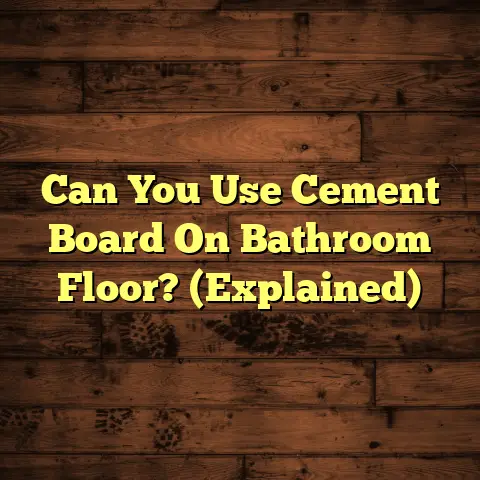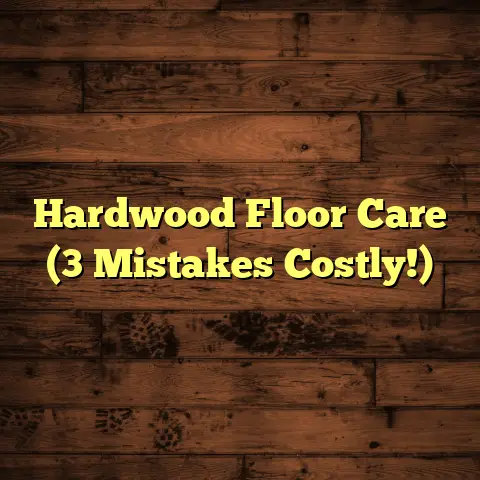Glue Down Click Lock Vinyl? (6 Warranty Voiders!)
Click Lock Vinyl: 6 Warranty Voiders You Need to Know
Have you ever stopped to think about how one tiny slip-up during flooring installation could completely wipe out the warranty on your brand-new glue down click lock vinyl? It’s a thought that doesn’t cross most people’s minds, but trust me, as a flooring contractor with years under my belt, it should.
Let’s dive into the world of glue down click lock vinyl, unravel the mysteries of warranties, and highlight those sneaky little mistakes that can cost you big time. I’m here to help you protect your investment and avoid those warranty headaches.
1. Overview of Glue Down
Click Lock Vinyl Flooring
So, what exactly is glue down click lock vinyl flooring? Well, imagine the durability and water resistance of vinyl, combined with the easy installation of a click lock system, and then add the extra security of adhesive. That’s glue down click lock vinyl in a nutshell.
Unlike traditional vinyl rolls, these come in planks or tiles that click together, but also require adhesive to secure them to the subfloor. This hybrid approach offers a sweet spot.
Benefits of This Flooring Option
Why is it so popular? Here’s the lowdown:
- Durability: It can handle heavy foot traffic like a champ. I’ve seen it hold up beautifully in busy households and commercial spaces.
- Water Resistance: Spills? No problem. This stuff is practically waterproof, making it ideal for kitchens, bathrooms, and basements.
- Ease of Maintenance: A quick sweep and mop, and you’re good to go. No special treatments or fussy routines required.
A Brief History
Vinyl flooring has been around for ages, but the click lock and glue down click lock variations are relatively new. They’ve exploded in popularity over the last decade as homeowners and businesses seek cost-effective, durable, and easy-to- install options. I remember back in the day, it was all about sheet vinyl.
Now, everyone’s looking for the plank look without the hassle of traditional hardwood.
2. Understanding Warranties
Okay, let’s talk warranties. I cannot stress this enough: read your warranty carefully. It’s not the most exciting read, I know, but it’s crucial.
The Importance of Warranties
A warranty is basically a manufacturer’s promise that their product will perform as expected for a certain period. It protects you, the buyer, from defects in materials or workmanship. Think of it as insurance for your floor.
Typical Coverage
For glue down click lock vinyl, warranties typically cover:
- Manufacturing Defects: Issues like delamination (layers separating) or inconsistencies in the finish.
- Wear Layer: This is the top protective layer. The warranty might cover excessive wear-through within a specified timeframe.
- Water Resistance: Some warranties cover damage from topical moisture (spills), but not flooding or subfloor moisture issues.
Financial Implications of Voided
Warranties
Here’s where things get real. If your warranty is voided, you’re on the hook for any repairs or replacements. That could mean hundreds, even thousands, of dollars out of your pocket.
Imagine having to replace an entire kitchen floor because of a preventable installation error. Not fun, right?
3. The 6 Warranty Voiders
Alright, let’s get down to the nitty- gritty. These are the six most common mistakes I’ve seen that can instantly invalidate your glue down click lock vinyl warranty.
Void #1: Improper Installation Techniques
This is a big one. How you install the floor matters a lot.
Common Installation Errors
- Not Using Enough Adhesive: Skimping on the glue is a recipe for disaster. The planks won’t be securely bonded, leading to movement, gaps, and eventually, failure.
- Incorrect Staggering of Planks: A random, staggered pattern is not just for looks; it adds structural integrity. If you install the planks in a uniform, predictable pattern, you’re weakening the floor.
- Forcing the Click Lock System: The click lock system is designed to fit together relatively easily. If you’re having to force it, something is wrong. You might damage the locking mechanism, which can lead to gaps and instability.
- Not Using Proper Spacers: Expansion gaps around the perimeter of the room are essential to allow the floor to expand and contract with temperature and humidity changes. Ignoring this can cause buckling or cracking.
Proper vs. Improper Installation
Let’s break it down:
| Feature | Proper Installation | Improper Installation |
|---|---|---|
| Adhesive | Evenly applied, manufacturer-approved type | Insufficient amount, wrong type, uneven application |
| Plank Pattern | Random, staggered pattern | Uniform, predictable pattern |
| Click Lock | Gentle fitting, no forcing | Forcing, damaging the locking mechanism |
| Expansion Gaps | Adequate gaps around the perimeter | No gaps or insufficient gaps |
| Rolling | Using a heavy roller after installation | Skipping rolling or using an inadequate roller |
Void #2: Failure to Prepare the Subfloor
Your subfloor is the foundation of your entire flooring project. If it’s not right, nothing else will be.
Significance of a Well-Prepared Subfloor
A properly prepared subfloor provides a smooth, level, clean, and dry surface for the vinyl to adhere to. It ensures stability, prevents moisture issues, and helps the flooring perform as intended.
Specific Subfloor Conditions That
Could Void the Warranty
- Moisture: This is the number one enemy of flooring. Excessive moisture in the subfloor can cause the adhesive to fail, leading to bubbling, warping, and mold growth. Always test the moisture level before installing. I recommend a moisture meter like the Wagner MMC220.
- Uneven Surfaces: Dips, bumps, or cracks in the subfloor will telegraph through to the vinyl, creating an uneven and unsightly surface. They can also put stress on the locking system, causing it to fail.
- Contaminants: Dust, dirt, grease, or old adhesive residue can interfere with the bond between the vinyl and the subfloor. A clean surface is essential.
- Instability: If the subfloor itself is unstable (e.g., loose plywood), the flooring will be too. This can lead to cracking and movement.
Void #3: Use of Non-Approved Adhesives
or Materials
Not all adhesives are created equal. Using the wrong one can have disastrous consequences.
Approved vs. Non-Approved Materials
- Approved: Always use the adhesive recommended by the flooring manufacturer. They’ve tested it to ensure compatibility and optimal performance. Look for terms like “approved for use with vinyl flooring” or “low-VOC” (volatile organic compounds).
- Non-Approved: Avoid using general-purpose construction adhesives or adhesives that are not specifically designed for vinyl flooring. These can contain chemicals that react negatively with the vinyl, causing discoloration, bubbling, or failure of the adhesive.
Chemical Compatibility
The adhesive needs to be chemically compatible with both the vinyl flooring and the subfloor. Incompatible adhesives can break down over time, releasing harmful chemicals or losing their adhesive properties.
I’ve seen cases where homeowners used the wrong adhesive, and the entire floor had to be ripped up and replaced because the adhesive never properly cured.
Void #4: Neglecting Environmental
Conditions
Your indoor environment plays a big role in the longevity of your floor.
Temperature and Humidity
- Temperature: Extreme temperature fluctuations can cause the vinyl to expand and contract, putting stress on the seams and the adhesive. Maintain a consistent temperature range, typically between 65°F and 85°F (18°C and 29°C).
- Humidity: High humidity can lead to moisture problems in the subfloor, while low humidity can cause the vinyl to become brittle and crack. Aim for a relative humidity level between 30% and 50%.
Recommended Environmental Controls
- HVAC System: A properly functioning HVAC system is essential for maintaining consistent temperature and humidity levels.
- Dehumidifier/Humidifier: If you live in an area with extreme humidity or dryness, consider using a dehumidifier or humidifier to maintain optimal conditions.
- Sun Control: Direct sunlight can cause the vinyl to fade or discolor. Use curtains, blinds, or window film to minimize exposure.
Void #5: Lack of Regular Maintenance
Even the most durable flooring needs proper care.
Maintenance Requirements
- Regular Cleaning: Sweep or vacuum regularly to remove dirt and debris. Mop with a pH-neutral cleaner specifically designed for vinyl flooring.
- Avoid Harsh Chemicals: Never use abrasive cleaners, bleach, or ammonia- based products. These can damage the finish and void the warranty.
- Protect from Scratches: Use furniture pads under heavy objects to prevent scratches. Avoid dragging furniture across the floor.
- Prompt Spill Cleanup: Wipe up spills immediately to prevent staining or moisture damage.
Wear and Tear
Neglecting proper maintenance can lead to premature wear and tear, such as scratches, stains, and fading. If the wear layer is compromised due to neglect, the warranty may be voided.
Void #6: Unauthorized Repairs or
Modifications
DIY repairs can be tempting, but they can also backfire.
Why DIY Repairs Are Detrimental
- Improper Techniques: If you’re not a professional, you might use the wrong tools or techniques, causing further damage.
- Incompatible Materials: Using the wrong adhesive or patching compound can create a visible discrepancy and void the warranty.
- Lack of Expertise: Repairing flooring requires skill and experience. A botched repair can make the problem worse and more expensive to fix.
Following Manufacturer Guidelines
Always follow the manufacturer’s guidelines for repairs. If you’re not comfortable doing it yourself, hire a qualified flooring contractor. It’s better to spend a little money upfront than to risk voiding the warranty and having to replace the entire floor.
4. Conclusion
So, there you have it – the six sneaky warranty voiders that can turn your flooring dream into a nightmare. Remember, knowledge is power.
By understanding these potential pitfalls and taking the necessary precautions, you can protect your investment and enjoy your beautiful glue down click lock vinyl flooring for years to come.
Do your homework, read the warranty carefully, and don’t be afraid to ask questions. And when in doubt, hire a professional. Trust me, it’s worth it.





